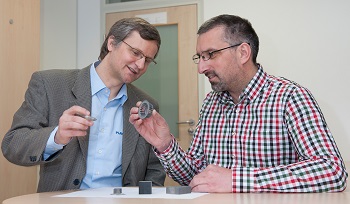Simply “print” complex shaped components? Following the model of the 3D-printing process of plastics, Plansee has now developed a selective laser melting process for refractory metals. The first components have already been delivered to customers.

How to realize a component made from refractory metal that looks like a honeycomb or another 3D-grid structure? A new process makes possible what seemed impossible until now: the selective laser melting.
This additive manufacturing process was perfected in the last years by Dr. Bernhard Tabernig (left) and Peter Singer for the manufacturing of tungsten and molybdenum products. It was challenging, because there is a great difference in the melting point and the machinability of refractory metals compared to other materials like plastic or steel.
Complex geometries and high yield of material.
The conventional powder metallurgical route at Plansee comprises the steps pressing of metal powder, sintering, forming and machining the metal component. Work-intensive non-cutting and cutting processes give the semifinished products such as sheets, blocks or rods their final shape.
The difference to selective laser melting: A thin layer of powder is applied on a base plate, one after another. The laser fuses the powder exactly at the point where the new component is to arise later. Non- melted powder can be used for the manufacturing of a new part. Apart from the high yield of material, the process of selective laser melting offers additional advantages: For the production of customer-specific components, neither special tools nor molds are needed. “Nearly all geometries are imaginable. The only input we need is a 3D drawing from our customer”, Bernhard Tabernig says enthusiastically. He is responsible for the development of new materials and technologies at Plansee.
The new process can be used, for example, in medical technology. “We have already constructed components for X-ray diagnostics. They have a particularly complex grid structure for absorbing the scattering radiation as good as possible”, explains Peter Singer, who as project engineer knows the new laser melting machine as well as nobody else at Plansee.“ Without the new manufacturing process we could not hold these products in our hands.”